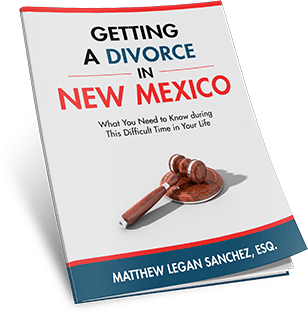
There are a handful of common temporary restraining order of protection questions. The answer to these questions provides readers with a better understanding of New Mexico protection order. Armed with this information, readers achieve a clearer picture of the rules and limits of restraining orders in NM.
CAN THE PERSON WHO FILED A TEMPORARY RESTRAINING ORDER CONTACT YOU?
The person who filed a restraining order (i.e., Protected Party ) usually is not legally prohibited from contacting the Restrained Party. At times, a counter restraining order is filed. When this happens, a temporary restraining order can be entered that prevents both parties from contacting one another.
Nevertheless, if a counter petition is not filed, then the Protected Party usually is not prevented from contacting the Restrained Party.
With that being said, the Protected Party contacting the Restrained Party after a temporary order is entered may lead to get restraining order being dismissed. In this respect, the contact may demonstrate that the Retrained Party does not pose a legitimate threat of harm to the Protected Party. Moreover, the contact can be reused to refute claims of harassment, or emotional abuse.
WHAT TYPE OF PROOF DO I NEED TO SUPPORT A TEMPORARY RESTRAINING ORDER?
The proof needed for a Temporary Restraining Order to be entered is probable cause that an act of abuse has occurred. Moving forward, a temporary restraining order can be entered when the facts demonstrate that it is more likely than not that an act of abuse has occurred, creating an immediate threat of harm to the victim.
The restraining order process begins by filing a Petition for Order of Protection. A Temporary Restraining Order (TRO) is entered if the reviewing judge believes that the Petition contains sufficient facts showing probable cause that an act of abuse occurred.
Under NM law, a hearing must take place within ten days of the TRO being granted. At this hearing, the Judge or Hearing Officer determines if the evidence demonstrates, by a preponderance of the evidence, that an act of abuse occurred. Moreover, the Hearing Officer determines if the alleged abuser poses an immediate threat of harm to the alleged victim. If so, a permanent restraining order is entered. However, the term “permanent” usually means that a protective order will be entered for six months to one year. In other words, “permanent” does not mean forever.
WHAT HAPPENS IF THE VICTIM VIOLATES THE TEMPORARY PROTECTION ORDER ?
At times, a victim (Protected Party) violates the temporary protection order by contacting the abuser (Restrained Party). However, often the order of protection only prevents the Restrained Party from contacting the Protected Party. Accordingly, the Victim/Protected Party is not violating a court order by contacting the Restrained Party, unless a mutual order of protection is entered. In other words, when the temporary protection order only prevents the Restrained Party from contacting the Protected Party, the Victim/Protected Party cannot be charged with violating an order of protection by contacting the Restrained Party.
However, the Protected Party contacting the Restrained Party may demonstrate that the Protected Party does not actually need an order of protection. In this regard, an order of protection is a serious order with serious consequences. As such, courts take restraining orders seriously. Because of this fact, the Protected Party’s act of contacting the Restrained Party can lead to the underlying restraining order being dismissed.
Has a temporary protection order been entered against you? If so, is the Victim/Protected Party contacting you? In this situation, you can file an Application to Terminate the Order of Protection from Domestic Abuse. In doing so, you can request to end the protective order based on the alleged Protected Party’s contact.
CAN A RESTRAINING ORDER STOP SOMEONE FROM TALKING ABOUT YOU?
A restraining order often prevents the Restrained Party from directly contacting or talking to the Protected Party. Moreover, getting a restraining order often prevents the Restrained Party from abusing the Protected Party – or the Protected Party’s household. With that said, a restraining order cannot prevent someone from talking about you, in a non-abusive way.
In other words, the Restrained Party likely is not violating the protection order merely by talking about you. However, the Restrained Party could be violating the order of protection if they are talking about you, to your household members, in an abusive manner.
Finally, a temporary protection order may prevent the Restrained Party from posting or causing someone to post anything about the Protected Party on any form of social media. This also includes posting about the Protected Party’s family members, significant other, and children.
HOW DOES A TEMPORARY RESTRAINING ORDER WORK IF YOU LIVE IN THE SAME HOUSE?
A temporary restraining order often forces one party out of the home, when both sides live within the same house.
A temporary restraining order (TRO) can be entered when probable cause demonstrates that an act of abuse has occurred. This TRO often forces one party out of the shared or martial home. At the TRO hearing, a permanent restraining order is either entered, or the case is dismissed. If a restraining order is entered, the order often controls who stays in the home.
If the restraining order is dismissed, then a court order does not prevent either party from living within the home. As such, who can live in the home is a gray area. The answer to this gray area depends on the home’s title, and if the parties are married.
WHAT ARE THE RESTRAINING ORDER NM RULES?
New Mexico’s restraining order rules enable a temporary restraining order to be entered when the petition/request demonstrates sufficient facts that an act of abuse has occurred. Under NM law, a hearing must be held within ten days.
At this hearing, the person requesting the restraining order must show that it is more likely than not that an act of abuse occurred. In doing so, the alleged victim must also show that the alleged abuser poses an immediate threat of future harm.
Ultimately, the assigned Judge or Hearing Officer decides if a restraining order is entered. In other words, the Hearing Officer/Judge has immense power to decide if a protective order is entered.
HOW TO WIN A PROTECTION ORDER HEARING IN NEW MEXICO
You can win a protection order hearing in New Mexico by showing that an act of abuse has occurred. An act of abuse is broad and includes physical/mental abuse, severe emotional distress, stalking, harassment, or damage to property.
You can use the following evidence to win your protection order hearing:
- Your testimony;
- Witnesses that have observed the abuse;
- Text messages/emails;
- Recordings;
- Pictures; or
- CYFD testimony regarding abuse/neglect to involved children.
You are not required to have restraining order defense attorney at a protection order hearing. However, you should always speak with an experienced protection order attorney before your protection order hearing in New Mexico. An experienced restraining order defense attorney can help you understand the strengthens and weaknesses of your case.
CAN YOU GET A RESTRAINING ORDER FOR SOCIAL MEDIA HARASSMENT?
Yes. You can get a restraining order for social media harassment – or any form of harassment. Harassment on Facebook, Twitter, Instagram, Snapchat, or otherwise, can be used to request a restraining order of protection.
However, you may encounter issues authenticating that the alleged abuser created the alleged social media account. Moreover, when the alleged abuser denies recognizing or creating the account, you may encounter issues laying the evidentiary foundation to introduce the posts into evidence.
In other words, at times, introducing social media posts into evidence can be difficult. Accordingly, you should speak with an experienced restraining order attorney regarding social media harassment.
HOW TO PROVE VIOLATION OF RESTRAINING ORDER IN NEW MEXICO
You can prove that the Restrained Party has violated the restraining order through the following:
- Your testimony;
- Text messages, emails, or social media posts demonstrating abuse/contact;
- Witness testimony;
- Recordings; or
- Pictures.
Violating a restraining order carries serious consequences. For a first offence, these consequences include being charged with a misdemeanor. This misdemeanor is punishable by imprisonment of up to three hundred and sixty-four days. Moreover, the punishment includes a fine of up to one thousand dollars, or both.
IS POSTING ON FACEBOOK A VIOLATION OF A RESTRAINING ORDER OF PROTECTION?
At times, posting on Facebook is a violation of a restraining order. Whether the post violates the temporary restraining order depends on the restraining order’s language.
For instance, look at your restraining order’s “contact prohibition.” In doing so, does this prevent the Restrained Party from posting about the Protected Party on social media? If so, then the Facebook post might be a violation of the restraining order.
TOP/BEST DOMESTIC VIOLENCE LAWYERS/ATTORNEY FOR RESTRAINING ORDERS IN NEW MEXICO
Are you the victim of domestic abuse? Conversely, are you facing false allegations/accusations of domestic abuse? In either situation, you need one of New Mexico’s best restraining order defense attorney. For over a decade, Matthew Legan Sanchez has handled protective orders all across New Mexico. Sanchez routinely handles restraining order of protections in Albuquerque, Rio Rancho, and Los Lunas/Belen. You deserve the best. Call (505) SANCHEZ today.








